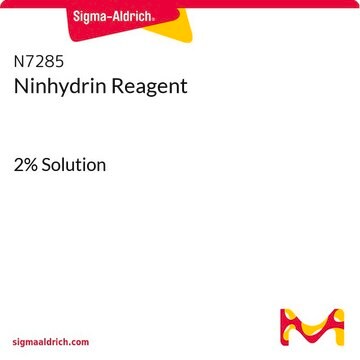Kluczowe dokumenty
21-1520
Ninhydrin
≥98.0%, suitable for amino acid analysis
Synonim(y):
1,2,3-Indantrione monohydrate, 2,2-Dihydroxy-1,3-indanedione, Trioxohydrindene monohydrate
About This Item
Polecane produkty
Próba
≥98.0%
Formularz
solid
dostępność
available only in Japan
mp
250 °C (dec.) (lit.)
przydatność
suitable for amino acid analysis
ciąg SMILES
OC1(O)C(=O)c2ccccc2C1=O
InChI
1S/C9H6O4/c10-7-5-3-1-2-4-6(5)8(11)9(7,12)13/h1-4,12-13H
Klucz InChI
FEMOMIGRRWSMCU-UHFFFAOYSA-N
Szukasz podobnych produktów? Odwiedź Przewodnik dotyczący porównywania produktów
Zastosowanie
Hasło ostrzegawcze
Warning
Zwroty wskazujące rodzaj zagrożenia
Zwroty wskazujące środki ostrożności
Klasyfikacja zagrożeń
Acute Tox. 4 Oral - Eye Irrit. 2 - Skin Irrit. 2
Kod klasy składowania
11 - Combustible Solids
Klasa zagrożenia wodnego (WGK)
WGK 3
Temperatura zapłonu (°F)
Not applicable
Temperatura zapłonu (°C)
Not applicable
Środki ochrony indywidualnej
dust mask type N95 (US), Eyeshields, Gloves
Wybierz jedną z najnowszych wersji:
Masz już ten produkt?
Dokumenty związane z niedawno zakupionymi produktami zostały zamieszczone w Bibliotece dokumentów.
Nasz zespół naukowców ma doświadczenie we wszystkich obszarach badań, w tym w naukach przyrodniczych, materiałoznawstwie, syntezie chemicznej, chromatografii, analityce i wielu innych dziedzinach.
Skontaktuj się z zespołem ds. pomocy technicznej








